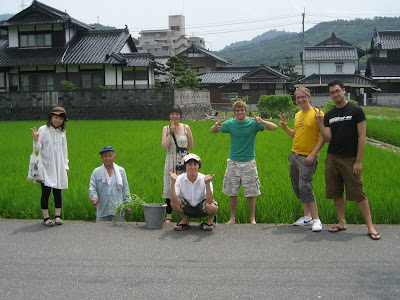
 We then headed to Hiroshima, where we stayed with a man named Shinta, the owner of the Novel Sounds label, and his family. Shinta lives on the outskirts of Hiroshima with his wife and his parents in a traditional house which has been owned by their family for over 100 years. The village, which was outside the area most affected by the A-bomb, is surrounded by tree-covered mountains and a wide clear river. It was in this setting that Shinta and his family set up a BBQ to welcome us, including Kobe beef. Shinta told us that in japan, Kobe beef cuts are classified into 15 levels, and that we were being served number 1 - the finest. To illustrate just how fantastic this was, you need only look up Kobe beef on wikipedia! The perfect accompaniment to this? Home-grown vegetables (including tomatoes, onions, pumpkin and watermelon) and rice.
We then headed to Hiroshima, where we stayed with a man named Shinta, the owner of the Novel Sounds label, and his family. Shinta lives on the outskirts of Hiroshima with his wife and his parents in a traditional house which has been owned by their family for over 100 years. The village, which was outside the area most affected by the A-bomb, is surrounded by tree-covered mountains and a wide clear river. It was in this setting that Shinta and his family set up a BBQ to welcome us, including Kobe beef. Shinta told us that in japan, Kobe beef cuts are classified into 15 levels, and that we were being served number 1 - the finest. To illustrate just how fantastic this was, you need only look up Kobe beef on wikipedia! The perfect accompaniment to this? Home-grown vegetables (including tomatoes, onions, pumpkin and watermelon) and rice.
The following day, Shinta took us on a walk and showed us where he and his family grow some of their crops. We then visited the local Buddhist shrine, which was around 530 years old. Stone steps paved the way to the entrance which was shadowed by two dragons (the east and west dragons) crafted from wood. The shrine was small but spectacular, and the priest was warm and welcoming. All major events of village life are celebrated there: blessing newborn babies, marriages and funerals.

After an impromptu paddle in the river to cool off from the heat of the day, we went to a Okonomiyaki (a large omelette with noodles, meat, onion and cheese inside. Yum!) shop to get take away. Our second major autograph experience came when the shop owners asked us to sign their wall(!) Yuka hesitantly made the first marks, followed by the rest of us:
Our packed day of sightseeing ended with a tour of a sake brewery. The small business is only operational in the winter due to the need to keep the heat low during production, but the massive 7000 litre barrels used in production still smelt strongly of the sake. The brewery utilised a mix of both modern and traditional techniques; some types of sake were predominantly prepared by machine, but some were the craft of the master sake makers, who spend 48 hours at a time preparing the alcohol. The trip ended with a tasting session of the various different types of sake, and the prices were so reasonable that we came away with a good many bottles ourselves!

We'd like to thank Shinta and his family for their incredible hospitality: they gave us ample sleeping space and kept us incredibly well fed, which we are incredibly grateful for (sleepiness and hunger being the two most defining features of TIMNS members according to Fumi). They showed us a way of life in Japan that is incredibly far removed from the bright neon lights and noise of places like Tokyo and Osaka, yet just as obviously and uniquely Japanese.
The following day, we visited the Hiroshima Peace Memorial museum. The effect of this place is obviously not something that can be easily blogged about. The museum itself is huge, and covers in an unbiased manner the history of Hiroshima, spanning from its time as an industrial pre-war city, through the wartime period, to information on the current nuclear climate worldwide. We were particularly impressed with Hiroshima's desire not to seem like the victim of a catastrophe but a voice for disarmament: to use the experience of its people to help fight for a safer world.
After this sobering experience, we set off to Yamaguchi for a dinner date with Little Phrase, who we were supporting the following evening. More to come on our Yamaguchi and Kyoto experiences next time!
Bloggingly yours,
Dave, Non & TIMNS



No comments:
Post a Comment